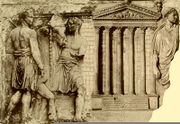Taurobolium
Home| Latíné | Deutsch | Español | Français | Italiano | Magyar | Português | Română | Русский | English
Contents |
History

The origins of this sacrifice, we can speculate, take root in Asia Minor and the Middle East. Mesopotamian priests known as kalu were known to have taken part in bull sacrifice, in Crete and Asia Minor we know of various bull-hunting rites. In Asia Minor, specifically, it was considered a rite of fertility to cut the throat of a bull in times of drought to bring forth rain.
On the basis that the deities who are typically associated with the Taurobolium originate from Asia Minor, Persia and the Middle East, it is a fair theory to understand the introduction of this sacrifice via those deities entrance into the Roman State.
The Sacrifice
According to the evidence, the Taurobolium appears to have been a sacrificial ritual that evolved over time:
- 134-160 CE: the Taurobolium seems to imply simply the sacrifice of a bull.
- 160-300 CE: the Taurobolium includes references to the “vires” of the bull in connection to a special tool known as the “cernus”.
- 300-later: the Taurobolium specifically refers to a type of blood-baptism.
Purpose
Deities
References